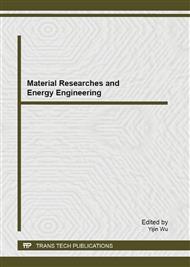[1]
Y.S. Song, J.R. Youn, T.G. Gutowski, Life cycle energy analysis of fiber-reinforced composites, Compos. Part A 40 (2009) 1257–1265.
DOI: 10.1016/j.compositesa.2009.05.020
Google Scholar
[2]
M. Valliappan, J.A. Roux, J.G. Vaughan, E.S. Arafat, Die and postdietemperature and cure in Graphite/Epoxy composites, Compos. Part B 27 (1996) 1-9.
DOI: 10.1016/1359-8368(95)00001-1
Google Scholar
[3]
P. Carlone, G.S. Palazzo, R. Pasquino, Pultrusion manufacturing process development by computational modelling and methods, Math. Comput. Model. 44 (2006) 701-709.
DOI: 10.1016/j.mcm.2006.02.006
Google Scholar
[4]
P. Carlone, G.S. Palazzo, Pultrusion manufacturing process development: Cure optimization by hybrid computational methods, Comput. Math. Appl. 53 (2007) 1464–1471.
DOI: 10.1016/j.camwa.2006.02.031
Google Scholar
[5]
I. Baran, C.C. Tutum, J.H. Hattel, Optimization of the thermosetting pultrusion process by using hybrid and mixed integer genetic algorithms, Appl. Compos. Mater. (2012), DOI: 10. 1007/s10443-012-9278-3.
DOI: 10.1007/s10443-012-9278-3
Google Scholar
[6]
I. Baran, C.C. Tutum, J.H. Hattel, The effect of thermal contact resistance on the thermosetting pultrusion process, Compos. Part B 95 (2013) 995-1000.
DOI: 10.1016/j.compositesb.2012.09.049
Google Scholar
[7]
K.S. Raper, J.A. Roux, T.A. McCarty, J.G. Vaughan, Investigation of the pressure behaviour in a pultrusion die for glass-fibre/epoxycomposites, Compos Part A 30 (1999) 1123–1132.
DOI: 10.1016/s1359-835x(98)00196-1
Google Scholar
[8]
H.L. Price, S.G. Cupschalk, Pulling Force and Its Variation in Composite Materials Pultrusion, in: C. D. Han (Ed. ), Polymer Blends and Composites in Multiphase Systems, ACS Publications, 1984, pp.301-322.
DOI: 10.1021/ba-1984-0206.ch018
Google Scholar
[9]
E. Lackey, J.G. Vaughan, An analysis of factors affecting pull force for the pultrusion of graphite/epoxy composites, J. Reinf. Plast. Comp. 13 (1994) 188-199.
DOI: 10.1177/073168449401300301
Google Scholar
[10]
P. Carlone, G.S. Palazzo, Viscous pull force evaluation in the pultrusion process by a finite element thermo-chemical rheological model, Int J Mater Form. 1 (2008) 831–834.
DOI: 10.1007/s12289-008-0264-0
Google Scholar
[11]
D. Srinivasagupta, S. Potaraju, J.L. Kardos, B. Joseph, Steady state and dynamic analysis of a bench-scale injectedpultrusion process, Compos. Part A 34 (2003) 835-846.
DOI: 10.1016/s1359-835x(03)00182-9
Google Scholar
[12]
P. Carlone, G.S. Palazzo, Thermo-chemical and rheological finite element analysis of the cure process of thick carbon-epoxy composite laminates, Int. J. Mater. Form. 2 (2009) 137-140.
DOI: 10.1007/s12289-009-0450-8
Google Scholar
[13]
P. Carlone, G.S. Palazzo, Flow monitoring and permeability measurements in LCM processes by the means of a dielectric sensor, Key Eng. Mat. 504-506 (2012) 289-294.
DOI: 10.4028/www.scientific.net/kem.504-506.289
Google Scholar
[14]
P. Carlone, G.S. Palazzo, A micro-scale model for fiber tow characterization under nondeterministic assumption: longitudinal and transverse permeability, submitted to Key Eng. Mat. (2013).
DOI: 10.4028/www.scientific.net/kem.554-557.2348
Google Scholar
[15]
S.C. Joshi, Y.C. Lam, Three-dimensional finite-element/nodal-control-volume simulationof the pultrusion process with temperature-dependent materialproperties including resin shrinkage, Composites Science and Technology 61 (2001) 1539–1547.
DOI: 10.1016/s0266-3538(01)00056-2
Google Scholar
[16]
M.W. Nielsen, J.W. Schmidt, J.H. Hattel, T.L. Andersen, C.M. Markussen, In situ measurement using FBGs of process-induced strains during curing of thick glass/epoxy laminate plate: experimental results and numerical modeling, Wind Energ. (2012).
DOI: 10.1002/we.1550
Google Scholar


